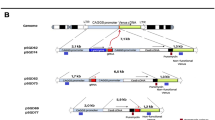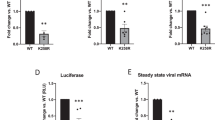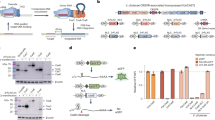Abstract
Using a liposomal transfection with purified bovine leukemia virus (BLV) integrase, we observed an efficient DNA rearrangement of a chromosomal repeat sequence and targeted integration of a part of the transfected plasmid. The BLV integrase recognition sequence (IRS) including the 3′ end of the BLV LTR U5, one of the sites cleaved by the integrase, was essential for the DNA rearrangement, and a sequence homologous to the chromosomal DNA neighboring the repeat target site had to be placed downstream of the IRS on the transfected plasmid. The pSV2neo DNA, including the pBR322 sequence preintegrated into L929 cells (primary transfectants), was rearranged by a secondary transfection of a pBR322-based hygromycin-resistance plasmid carrying the IRS. We present a model to explain the chromosomal DNA rearrangement of the primary clones through a homologous recombination-like reaction and amplification of the neighboring sequences.
This is a preview of subscription content, access via your institution
Access options
Subscribe to this journal
Receive 12 print issues and online access
$259.00 per year
only $21.58 per issue
Buy this article
- Purchase on Springer Link
- Instant access to full article PDF
Prices may be subject to local taxes which are calculated during checkout





Similar content being viewed by others
References
Linden RM et al. Site-specific integration by adeno-associated virus. Proc Natl Acad Sci USA 1996; 93: 11288–11294.
Rutledge EA, Russel DW . Adeno-associated virus vector integration junctions. J Virol 1997; 71: 8429–8436.
Heister T, Heid I, Ackerman M, Fraefel C . Herpes simplex virus type 1/adeno-associated virus hybrid vectors mediate site-specific integration at the adeno-associated virus preintgration site, AAVS1, on human chromosome 19. J Virol 2002; 76: 7163–7173.
Russell DW, Hirata RK . Human gene targeting by viral vectors. Nat Genet 1998; 18: 325–330.
Verma IM, Somia N . Gene therapy – promises, problems and prospects. Nature 1997; 389: 239–242.
Morita S, Kojima T, Kitamura T . Plat-E: an efficient and stable for transient packaging of retroviruses. Gene Therapy 2000; 7: 1063–1066.
Bushman FD . Targeting survival: integration site selection by retrovirus and LTR-retrotransposons. Cell 2003; 115: 135–138.
Wu X, Li Y, Crise B, Burgess SM . Transcriptional start regions in the human genome are favored targets for MuLV integration. Science 2003; 300: 1749–1751.
Rosenberg N, Joricoeur P . Retroviral pathogenesis. In: Coffin JM, Stephen H, Hughes H, Varmus HE (eds). Retroviruses. Cold Spring Harbor Laboratory Press: New York, 1997, pp 475–585.
Hacein-Bey-Abina S et al. A serious adverse event after successful gene therapy for X-linked severe combined immunodeficiency. N Engl J Med 2003; 348: 255–256.
Bushman FD, Miller MD . Tethering human immunodeficiency virus type 1 preintegration complexes to target DNA promotes integration at nearby sites. J Virol 1997; 71: 458–464.
Holmes-son ML, Chow SA . Integrase-lexA fusion proteins incorporated into human immunodeficiency virus type 1 that contains a catalytically inactive integrase gene are functional to mediate integration. J Virol 2000; 74: 11548–11556.
Tan W et al. Fusion proteins consisting of human immunodeficiency virus type 1 integrase and the designed polydactyl zinc protein E2C direct integration of viral DNA into specific sites. J Virol 2004; 78: 1301–1313.
Engelman et al. Multiple effects of mutations in human immunodeficiency virus type 1 integrase on viral replication. J Virol 1995; 69: 2729–2736.
Zhu K, Donald C, Chow SA . Requirement for integrase during reverse transcription of human immunodeficiency virus type 1 and the effect of cysteine mutations of integrase on its interactions with reverse transcriptase. J Virol 2004; 78: 5045–5055.
Tanaka AS, Mizuochi T, Komuro K . Gene transfer using purified retroviral integrase. Biochem Biophys Res Commun 1994; 203: 1756–1764.
Tanaka AS, Tanaka M, Komuro K . A highly efficient method for the site-specific integration of transfected plasmids into the genome of mammalian cells using purified retroviral integrase. Gene 1998; 216: 67–76.
Southern PJ, Berg P . Transformation of mammalian cells to antibiotic resistance with a bacterial gene under control of the SV40 early promoter. J Mol Appl Genet 1982; 1: 327–341.
Sagata N et al. Complete nucleotide sequence of the genome of bovine leukemia virus: its evolutionary relationship to other retroviruses. Proc Natl Acad Sci USA 1985; 82: 677–681.
Sugden B, Marsh K, Yates J . A vector that replicates as a plasmid and can be efficiently selected in B-lymphoblasts transformed by Epstein–Barr virus. Mol Cell Biol 1985; 5: 410–413.
Katz RA, Skalka AM . The retroviral enzymes. Annu Rev Biochem 1994; 63: 133–173.
Brown PO . Integration. In: Coffin JM, Stephen H, Hughes H, Varmus HE (eds). Retroviruses. Cold Spring Harbor Laboratory Press: New York, 1997, pp 161–203.
Sherdin U, Rhodes K, Breindl M . Transcriptionally active genome region are preferred targets for retrovirus integration. J Virol 1990; 64: 907–912.
Sherman PA, Fyfe JA . Human immunodeficiency virus integration protein expressed in Escherichia coli possesses selective DNA cleaving activity. Proc Natl Acad Sci USA 1990; 87: 5119–5123.
McClements WL et al. A frequent site-specific deletion of coliphage lambda murine sarcoma virus recombinants and its use in the identification of a retrovirus integration site. J Virol 1980; 35: 488–497.
Peden KW . Instability of HIV sequence in high copy number plasmids. J AIDS 1992; 5: 313–315.
Yamada K, Morozumi H, Okamoto T . LTR-directed homologous recombination of full-length HIV-1 provirus clone in recA(-) bacteria. Arch Virol 1995; 140: 1007–1014.
Bischerour J et al. The (52-96) C-terminal domain of Vpr stimulates HIV-1 IN-mediated homologous strand transfer of mini-viral DNA. Nucleic Acids Res 2003; 31: 2694–2702.
Delviks KA, Pathak VK . Development of murine leukemia virus-based self-activating vectors that efficiently delete the selectable drug resistance gene during reverse transcription. J Virol 1999; 73: 8837–8844.
Yu SS et al. Construction of a retroviral vector production system with the minimum possibility of a homologous recombination. Gene Therapy 2003; 10: 706–711.
Amann E, Brosius J . ATG vectors for regulated high-level expression of cloned genes in Escherichia coli. Gene 1985; 40: 183–190.
Sambrook J, Fritsch E, Maniatis T . Molecular Cloning: A Laboratory Manual, 2nd ed. Cold Spring Harbor Laboratory Press: New York, 1989.
Felgner PL et al. Lipofectin: a highly efficient, lipid-mediated DNA-transfection procedure. Proc Natl Acad Sci USA 1987; 84: 7413–7417.
Acknowledgements
We thank Professor H Koyama of the Kihara Institute for Biological Research at Yokohama City University for critical reading and helpful discussions. We also thank Mr C Moreby for preparation of the manuscript. This work was supported in part by a grant from the Foundation of Human Health Sciences.
Author information
Authors and Affiliations
Rights and permissions
About this article
Cite this article
Tanaka, A., Komuro, K. Targeted rearrangement of a chromosomal repeat sequence by transfection of a homologous DNA sequence using purified integrase. Gene Ther 12, 783–794 (2005). https://doi.org/10.1038/sj.gt.3302458
Received:
Accepted:
Published:
Issue Date:
DOI: https://doi.org/10.1038/sj.gt.3302458
Keywords
This article is cited by
-
Mechanisms of leukemogenesis induced by bovine leukemia virus: prospects for novel anti-retroviral therapies in human
Retrovirology (2007)
-
Generation of Recombinant Chinese Hamster Ovary Cell Lines by Microinjection
Biotechnology Letters (2006)



